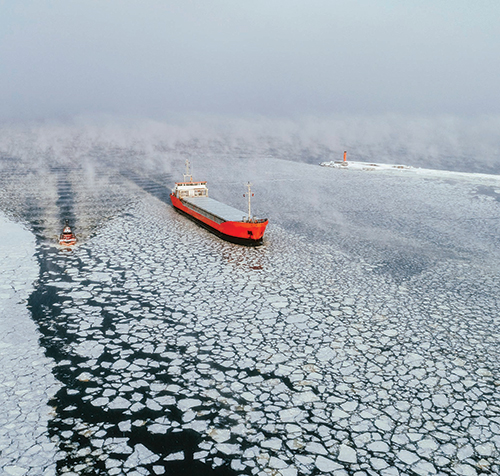
MSS Case October: Mistakes during maintenance lead to blackout and grounding
The vessel was in ballast and sailing about 7 miles from land on its way to the loading port in the NW Atlantic.
It was early spring and there were strong winds and large waves. There was also ice in the water and, as a consequence, the crew had to clear the lower starboard sea-chest which had become blocked with ice. The crew changed to the upper intake and then removed the large cover from the lower sea suction filter, finding it choked up with ice slush. While removing the ice, the main seawater valve, located on the side shell plate, began to leak.
The crew tried replacing the filter cover and one of the engineers applied a large valve wheel key to the valve in an attempt to stop the leakage. Unfortunately, too much force was applied and the gear mechanism that operates the valve spindle and opens and closes the valve, located in the
valve cover, was damaged and water began leaking into the engine room at a high pressure.
The crew attempted to stop the leak but the pressure and volume of water was too great. They then tried to pump out the water entering the engine room, but this was also unsuccessful as the electric motors and control gear were covered with seawater, causing short circuits and disabling the pumps. The vessel blacked out and began drifting in the severe weather conditions.
The vessel continued to drift approximately 6-7 miles off the coast. The coastguard arrived at the scene and tried to attach a tow line, however attempts failed. Following this the vessel dropped both anchors but this did not stop the vessel drifting. It eventually grounded and approximately 30
minutes later the crew was evacuated. A day later the weather had improved and a salvage team boarded the vessel by helicopter. Wires were connected from the grounded vessel to two tugs and the vessel was refloated and towed to the nearest port.
An underwater inspection revealed extensive damage to the vessel’s shell plating. Operations continued over the following days, cleaning the engine room with high pressure washing and removing the pollutant from the vessel. The vessel had to dry dock to carry out the repairs.
Questions
When discussing this case please consider that the
actions taken at the time made sense for all involved. Do
not only judge but also ask why you think these actions
were taken and could this happen on your vessel?
- What were the immediate causes of this accident?
- Is there a risk that this kind of accident could
happen on our vessel? - Should a work permit have been completed?
- Do we have a risk assessment on board that
addresses these risks? - Do we practice MRM (maritime resource
management) on board our vessel? - Do we have procedures which deal with a salvage
operation?
- Is everyone aware where to find the salvage
procedures and what their designated duty is
during a salvage? - How could this accident have been prevented?
- Do we have procedures which address the
problems in this scenario? - How could we improve our SMS to prevent this
accident from happening on our vessel? - If we had done the job like this, what sections of
our SMS would have been breached, if any? - Is our SMS sufficient to prevent this kind of
accident? - If procedures were breached, why do you think
this was the case? - Do our procedures make sense in terms of the
work we actually do? - What can we learn?
Download the case as PDF

MSS Case October: Mistakes during maintenance lead to blackout and grounding
It was early spring and there were strong winds and large waves. There was also ice in the water and, as a consequence, the crew had to clear the lower starboard sea-chest which had become blocked with ice.
For more Loss Prevention information, please contact:
Joakim Enström, Loss Prevention Officer
E-mail: joakim.enstrom@swedishclub.com
Each month, the Club’s Loss Prevention team issues a new safety scenario to assist members in their efforts to comply with international safety regulations and follow best practices.